
 |
|
#16
|
||||
|
||||
|
That's the prettiest bracing I've ever seen on a guitar! My jaw hit the floor when I saw that. Great job, Steve! The rest of the guitar is looking beautiful as well and I really like your new logo plaque inside... but that bracing is really a work of art.
 I hope to see more pics as this progresses. I hope to see more pics as this progresses.JR |
|
#17
|
|||
|
|||
|
brother,
I've said it before, but I'll say it again. I will one day own a guitar you built... this is just stunning stuff.
__________________
Larrivee L-03 SO |
|
#18
|
|||
|
|||
|
I love the symbolology comments. No offense taken at all. Thats what I love about the AGF and why I posted. I like to stir the pot a little bit in general anyway. It makes me laugh because Steve and I had some similar dialogue. I know the symbols arent everybody's flavor but they make the guitar for me at least visually and conceptually. I wanted to get the "bells and whistles" I have never had on a guitar before, but at the same time I was concerned about having it be too flashy. Steve was admittedly concerned about putting that many inlays on the guitar in all honesty. We didnt want to detract from the design or the beautiful tonewood we were lucky enough to get our hands on. I think his solution was quite clever to put them in black MOP such that they are almost camouflaged in the background. You really have to look at a certain angle to pick them up especially with the marbled fingerboard and black headplate. Looking straight on, the guitar looks far less "blingy". The only thing that really pops is that awesome rosette which was what we were after. Same goes for the trim around the guitar. The black MOP is very thin and camouflaged and really has to be seen at an angle to show. Awesome!
Without getting too sentimental, what I appreciated so much about Steve's approach was that it was very careful and well thought out. He charged me for a regular build but I know for a fact he had to really research the nuances of nylon guitar building and had to spend far more time on this guitar than his usual steel string. Very generous and progressive. Too me, the bracing experiement was not quite as risky as it appears. Nothing here was just thrown together without careful consideration. Steve actually made a pilot top using comparable tonewoods before actually committing that bracing to the very cool redwood we found. I have a used Cervantes Crossover 1 that I got to take the classical lessons with. That is by far my favorite guitar now but I think it lacks a little in power and volume. I have great reservations about double tops (another way to gain volume) with regards to longevity. So the main concern I voiced to Steve was about the lack of volume with traditional bracing and design in the setting of a crossover guitar. I am new to classical and frankly my attack is lighter than it should be so I asked Steve to brainstorm with something new to gain me volume without a double top. Based on the testing so far, I think he is right on track. For all the steel stringers out there, you gotta try a nylon hybrid/crossover. They feel just like what we're used to but open up a whole new world of music. I still cant stand the way classical necks feel so I'm glad hybrids are out there now. |
|
#19
|
||||
|
||||
|
A word or two about the symbolic content of this guitar--
In Paul's introductory words at the top of this build thread, you may have noticed that he's calling this guitar "Molly", which is based on "M.O.L." the acronym for "Meaning Of Life". Paul has been a very inspiring guy to work with on this project. I've come to know him as a passionate, enthusiastic, and highly committed person, who has a very strong and well-defined value system, in which his family, faith, and work are of great importance. He obviously loves his wife and children very much, and they are to him the ultimate meaning of life. The astrological symbols on the fingerboard represent each family member. The Celtic trinity knot at the end of the fingerboard represents Paul's spiritual faith. The double-helix rosette represents the elemental nature of life itself. And Paul also wanted to include a Caduceus symbol, as he and his wife are both physicians, practitioners of the healing arts. We decided to put the Caduceus on the back of the headstock. The materials used are sunburst black MOP, brass, copper, and abalone dots. 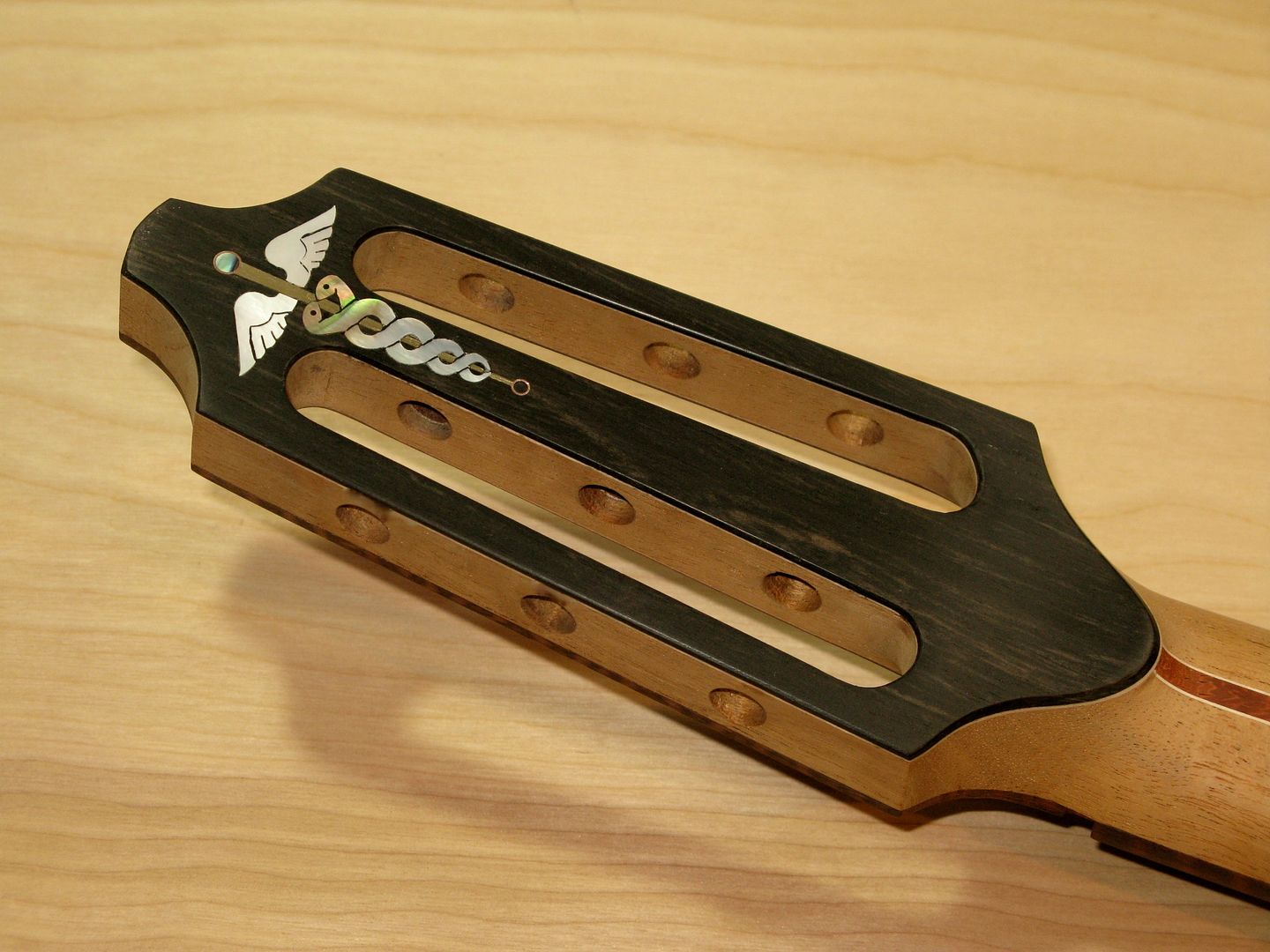 I have been asked by quite a few clients to include symbolic content on their guitars that have a lot of personal meaning. To me, this makes each one of these projects even more special. It has really been a treat working with Paul on his "Meaning of Life" guitar, because he is a man of great heart and soul. I just hope my interpretations come close to worthiness.
__________________
Edwinson |
|
#20
|
||||
|
||||
|
While we're at it--I thought a view of the back of the guitar would be appropriate. The back and sides are probably the finest set of African Blackwood I've seen yet. It has tonal properties that rival the best Brazilian RW. The sides bent like a dream--absolutely no ripple or warp. I think I spent all of thirty minutes block-sanding the sides after the box was put together.
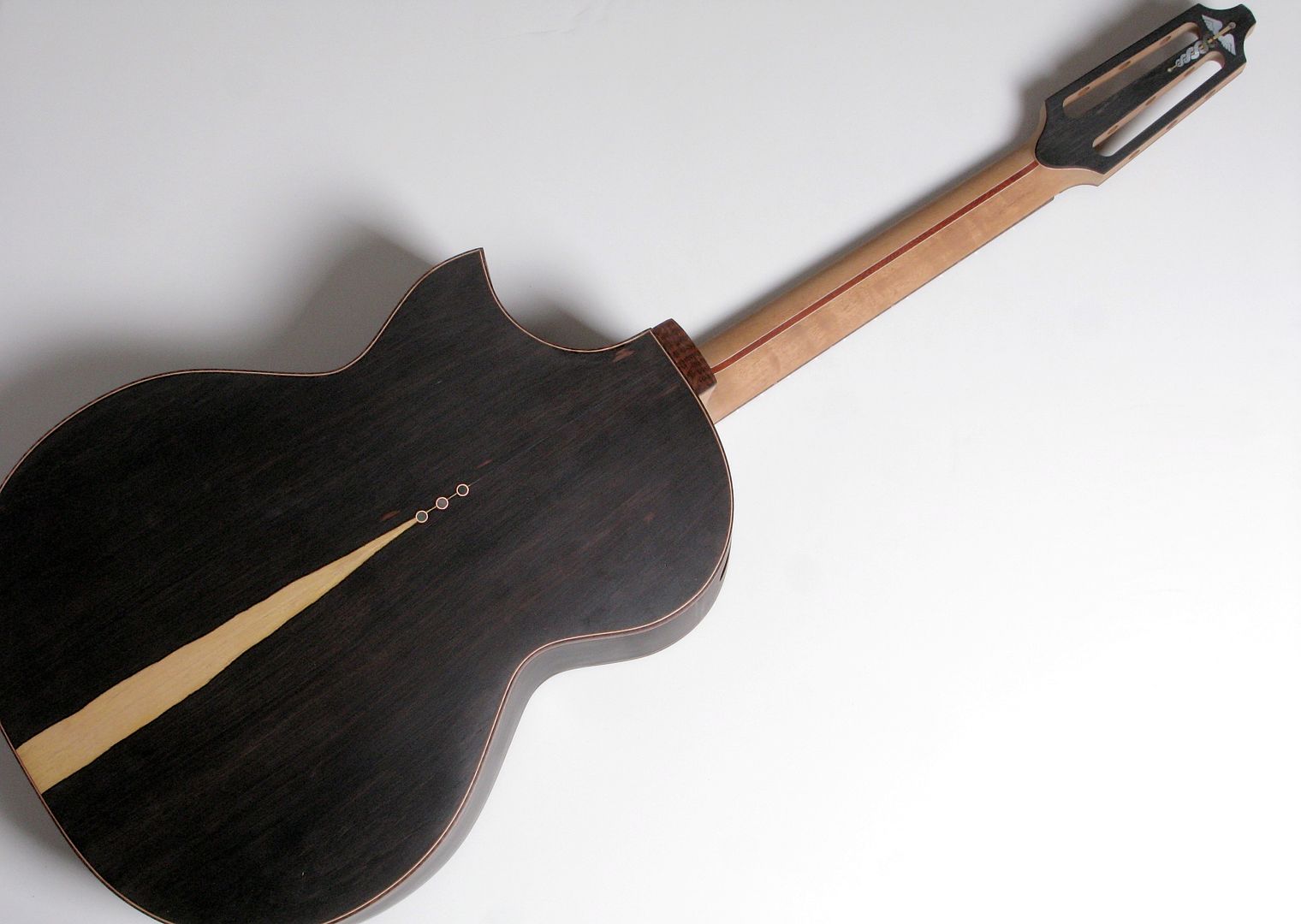 In a fit of whimsy, I decided to add three 1/4" black pearl dots, encircled in copper rings, to add a little punctuation to the top of the sapwood center.
__________________
Edwinson |
|
#21
|
|||
|
|||
|
Sweet guitar!
__________________
Guild CO-2 Guild JF30-12 Guild D55 Goodall Grand Concert Cutaway Walnut/Italian Spruce Santa Cruz Brazilian VJ Taylor 8 String Baritone Blueberry - Grand Concert Magnum Opus J450 Eastman AJ815 Parker PA-24 Babicz Jumbo Identity Walden G730 Silvercreek T170 Charvell 150 SC Takimine G406s |
|
#22
|
||||
|
||||
|
What a nice touch!!
__________________
--------------------------------------- 2013 Joel Stehr Dreadnought - Carpathian/Malaysian BW 2014 RainSong H-OM1000N2 2017 Rainsong BI-WS1000N2 2013 Chris Ensor Concert - Port Orford Cedar/Wenge 1980ish Takamine EF363 complete with irreplaceable memories A bunch of electrics (too many!!) |
|
#23
|
|||
|
|||
|
On the home stretch! Last pictures before the lacquer and final finishing details. Steve designed this awesome BRW bridge for my nylon crossover, the details of which he can delve into to compare and contrast from steel string bridge.
[IMG] 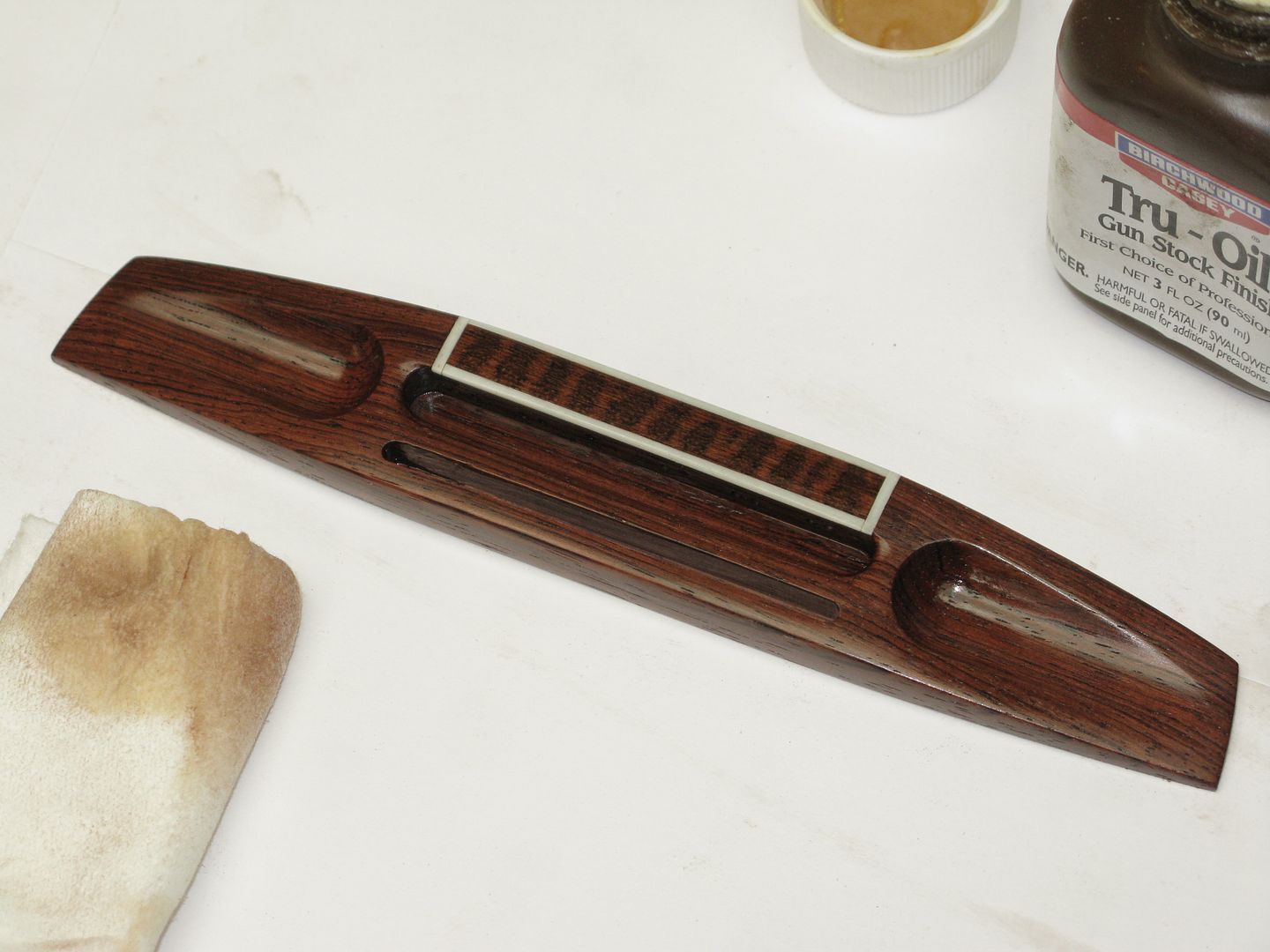 [/IMG] [/IMG][IMG]  [/IMG] [/IMG][IMG]  [/IMG] [/IMG][IMG]  [/IMG] [/IMG]
|
|
#24
|
||||
|
||||
|
What a unique and visionary approach to guitar-building....that bridge is a great example of Steve's integration of form and function, of his striving to make something both do its work and bring beauty. Very cool. Thanks for sharing the pics!
MK |
|
#25
|
|||
|
|||
|
I like the look of the guitar and admire the innovative strutting design. Does the inside of the guitar have a finish on it?
|
|
#26
|
||||
|
||||
|
I really appreciate the kind comments...Thank you all for your thought-provoking input.
With just about every aspect of this guitar's design and construction, I had to do a lot of research to reveal the mysterious arcana of what makes a nylon string guitar work. The bridge was certainly no exception. I made three attempts at coming up with a design that accomplishes all the functional objectives, and also looks like it belongs on this (highly iconoclastic) guitar. It was like using a machete to hack my way into a dense thicket of unknowns. How much should this bridge weigh? What's the best wood to use? How tall does it need to be? Should I go for a really low Flamenco-style bridge, or a taller classical style? What is the optimum string break-angle from the tie block to the saddle? What's the best way to tie on the strings? And, HOW DO I MAKE THE THING? Here's a photo of the sequence of my explorations: 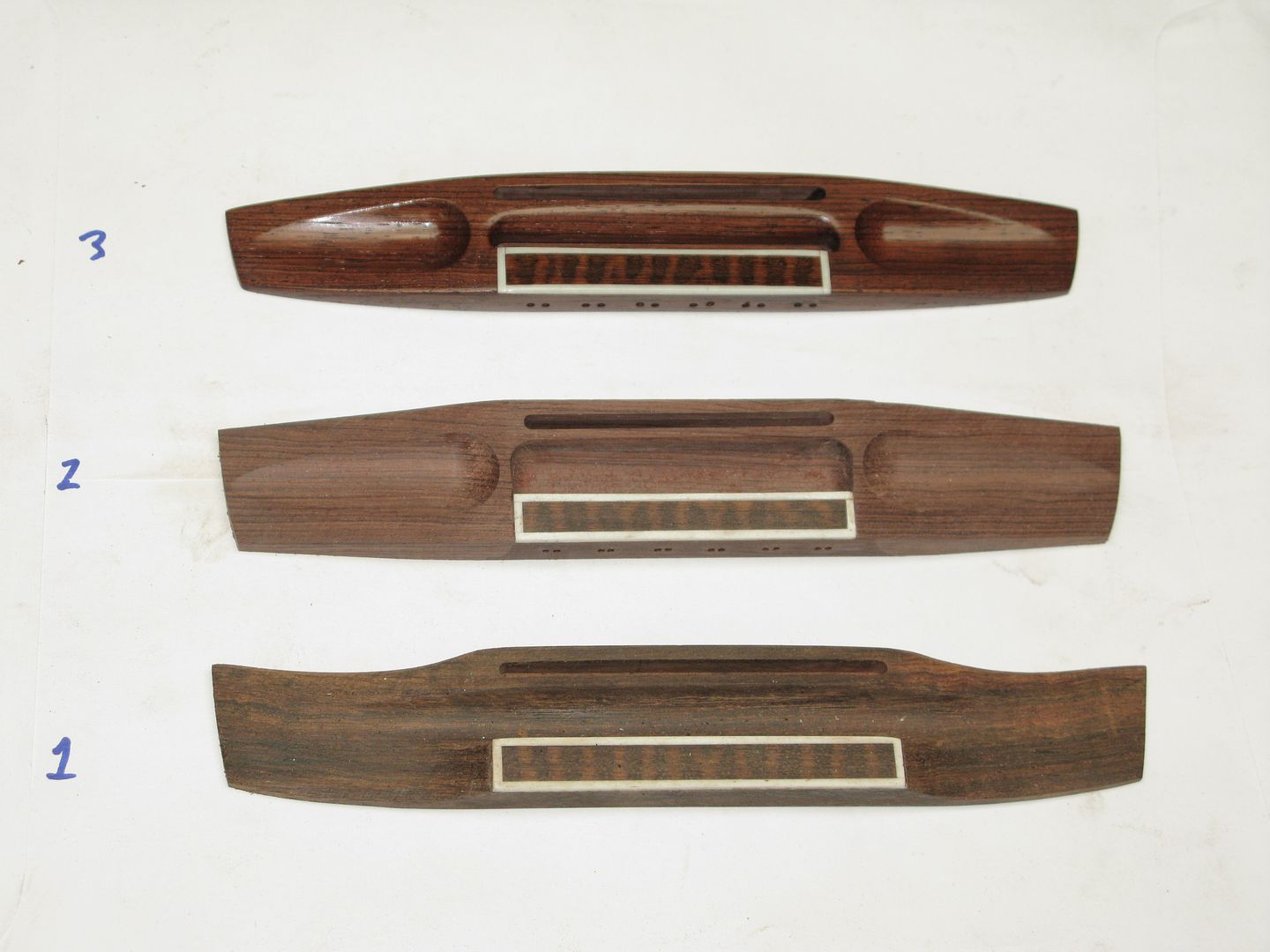 First of all--Brazilian rosewood is the best material to use. Fortunately, I have some, and it's the perfect cut for making bridges. When I cut out some bridge blanks, I dropped them on the cast iron surface of the table saw. They make this metallic Clinkety-clink sound. Good. This wood is amazingly resonant. Next, I wanted to make this bridge as lightweight as possible, while maintaining good rigidity. I like the design of classical bridges by John Gilbert and Sergei DeJonge. Very modern looking, and highly efficient design. I decided to riff on that idea--sculpting the bridge so it acts like an I-beam, with very low mass. After several false starts, I figured out a jig to do most of the machining on my drill press. As usual, all this over-complicated thinking winnows down to ultimate simplicity. 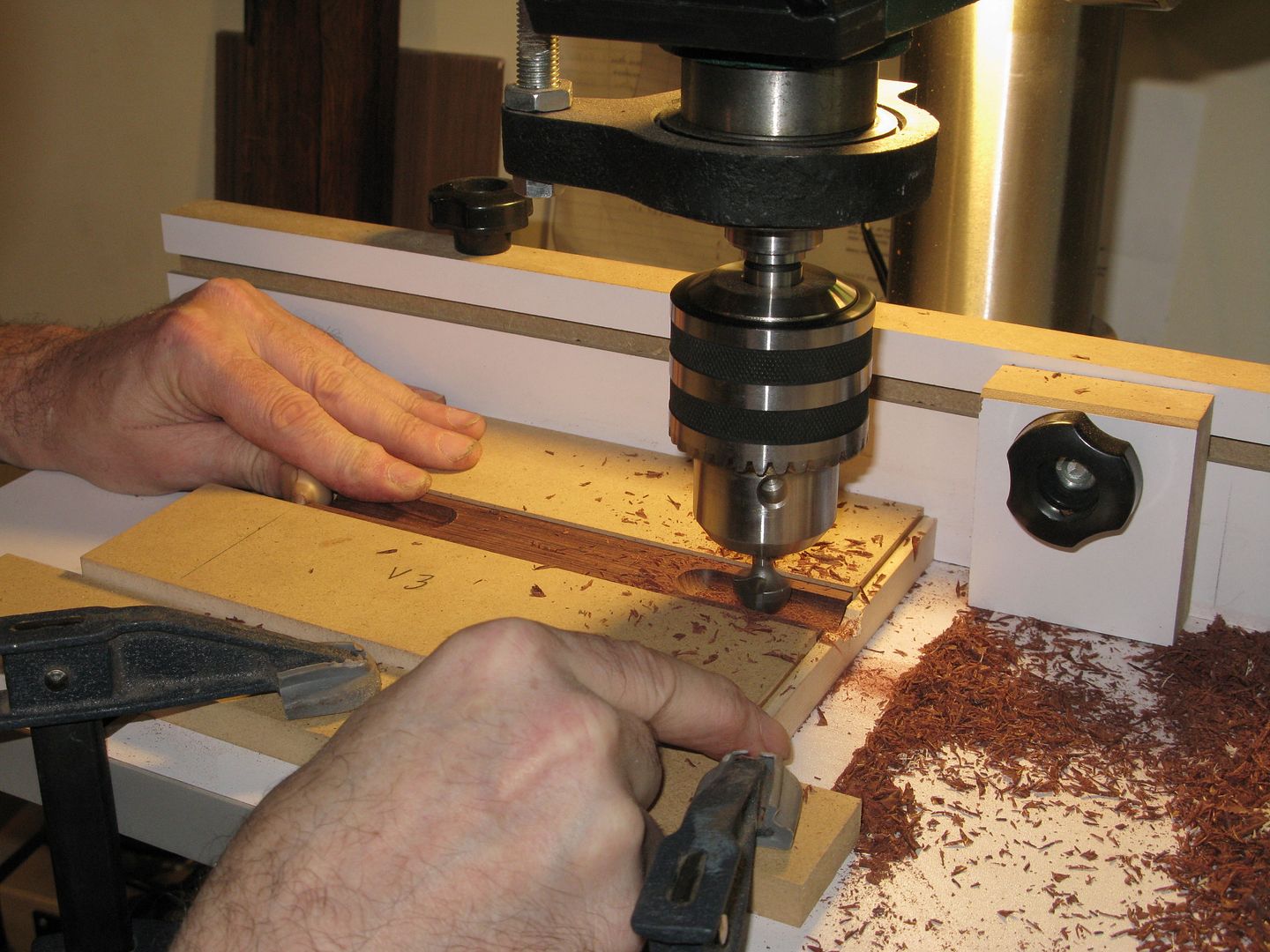 I decided to make the bridge height more to the specs of a classical guitar, rather than a Flamenco. The guitar's top is built to a 25' radius, which, with the neck angle, gives a bridge height of 11/32nds. With the saddle in place, we'll get a break angle from tie block to saddle of fifteen degrees--which will insure plenty of down-pressure on the saddle. And here's a secret: The saddle slot is cut fairly deep. There's enough wood left at the bottom of the slot to provide a good foundation for the saddle, but I didn't want to leave a lot of mass under there. I want as much of that string energy to go directly into the top as possible. The way the bracing is designed is part of this overall scheme. Finally, I drilled double string holes into the tie block to make tying on the strings fast, easy, and slip-proof. Today I begin the lacquer work. The guitar is all prepped and detailed, and ready for the first sealer coat. I'm using Seagrave nitrocellulose, which is the reincarnation of the defunct McFadden's lacquer that I used for twelve years. I just recently finished using the Seagrave stuff on Mark Kunkel's Zephyr Multiscale, and I have to say, so far anyway, this is the best lacquer I've ever used. I don't have ANY of the issues I had with other brands, even the original McFadden's. No micro-bubbles, hazing, fisheye... Thinned about 10%, it goes on in thin, even coats with perfect flow-out. And it seems to cure in about half the time as the McF's. Love it, love it, love it! They claim that this is the exact same formula as the McFadden's. But they must have changed something. I like this lacquer even better. I'm even happy to pay nearly twice as much for it as the McF's used to cost.
__________________
Edwinson |
|
#27
|
||||
|
||||
|
Quote:
I started doing this about eight years ago, after getting a tip from Ervin Somogyi. It just makes sense that with this elaborately done finish on the outside, if the wood is also sealed on the inside, it's likely to make the guitar more stable against changes of humidity. The guitar will expand and contract at a slower rate due to environmental fluctuations, than it would otherwise. And as Professor Somogyi says, a very thin sealer coat of shellac isn't going to have any discernible effect on the tone.
__________________
Edwinson |
|
#28
|
|||
|
|||
|
Lovely guitar.
Do you have any recordings of your guitars. thx, Stuart |
|
#29
|
||||
|
||||
|
Quote:
I have been very remiss at posting sound clips--mostly because, since I started building guitars in 2000, I have been playing less and less, and I think recording myself, with my rusty chops, would do more harm than good. However, here are a couple of links to YouTube videos, which feature two of my early guitars. The first one is my first prototype Consort guitar; the second one is Don Alder from Vancouver BC, playing my sixth guitar, a Performance cutaway model from 2003. http://www.youtube.com/watch?v=nsOqt4SilK8 http://www.youtube.com/watch?v=srzJB7muK-U Of course, these are both steel-string guitars. This one I'm building for Paul is my first crossover nylon string, so the jury is still out. Paul just emailed me this morning to say he's going to have his guitar teacher record some sound clips after the guitar arrives. So we'll see...and hear... As you may have already guessed, I'm not very good at following recipes, and I'm no slave to tradition. The design and construction of Paul's guitar came about from a combination of a great deal of research into nylon string guitars, and then throwing out 90% of the traditional methodology, circling back around with some new engineering and construction concepts that I REALLY, REALLY HOPE will prove out on the plus side. Paul is taking a giant leap of faith in having me do this; but I feel quite confident of a good result. If this guitar turns out to be a winner, I will be adding the nylon string crossover to my line. Otherwise, I will have to go back to dumpster diving and ditch digging for a living.
__________________
Edwinson |
|
#30
|
|||
|
|||
|
Very articulate sound with very pleasing tonal qualities. The performance cutaway sounds particularly outstanding.
Stuart |